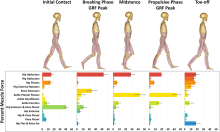Reconstructing the locomotor behavior of extinct animals depends on elucidating the principles that link behavior, function, and morphology, which can only be done using extant animals. Within the human lineage, the evolution of bipedalism represents a critical transition, and evaluating fossil hominins depends on understanding the relationship between lower limb forces and skeletal morphology in living humans. As a step toward that goal, here we use a musculoskeletal model to estimate forces in the lower limb muscles of ten individuals during walking. The purpose is to quantify the consistency, timing, and magnitude of these muscle forces during the stance phase of walking. We find that muscles which act to support or propel the body during walking demonstrate the greatest force magnitudes as well as the highest consistency in the shape of force curves among individuals. Muscles that generate moments in the same direction as, or orthogonal to, the ground reaction force show lower forces of greater variability. These data can be used to define the envelope of load cases that need to be examined in order to understand human lower limb skeletal load bearing.
